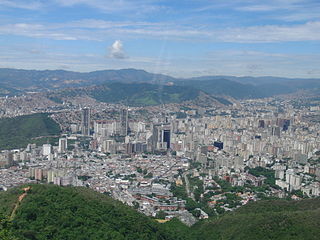
Caracas, officially Santiago de León de Caracas (CCS), is the capital and largest city of Venezuela, and the center of the Metropolitan Region of Caracas. Caracas is located along the Guaire River in the northern part of the country, within the Caracas Valley of the Venezuelan coastal mountain range. The valley is close to the Caribbean Sea, separated from the coast by a steep 2,200-meter-high (7,200 ft) mountain range, Cerro El Ávila; to the south there are more hills and mountains. The Metropolitan Region of Caracas has an estimated population of almost 5 million inhabitants.

Miranda State is one of the 23 states of Venezuela and the second most populous after Zulia State. As of the 2011 census, it had a population of 2,675,165 residents. It also has the greatest Human Development Index in Venezuela, according to the Venezuelan National Institute of Statistics. The most recent population estimate was 3,194,390 in mid-2016.

The Capital District is a federal district of Venezuela. It has an area of 433 km2 (167 sq mi) and there is only one administrative division (municipio), Libertador, which contains about half of Caracas, the Venezuelan capital city, which is also the seat of the three branches of the federal government of Venezuela. The population in 2004 was 2,073,768. The District borders on the states of Vargas and Miranda.

Barcelona is the capital of Anzoátegui State, Venezuela, and was founded in 1671. Together with Puerto La Cruz, Lecheria and Guanta, Barcelona forms one of the most important urban areas of Venezuela, with a population of approximately 950,000.

Chacao is one of the five political and administrative subdivisions of the city of Caracas, Venezuela. The other four are Baruta, El Hatillo, Libertador and Sucre. This legal entity is known as the Caracas Metropolitan District. Chacao is also one of the 21 municipalities that make up the State of Miranda, Venezuela.

El Hatillo Municipality is an administrative division of the State of Miranda, Venezuela; along with Baruta, Chacao, Libertador and Sucre, it is one of the five municipalities of Caracas, the capital of Venezuela. It is located in the southeastern area of Caracas, and in the northwestern part of the State of Miranda.

The University City of Caracas, also known by the acronym CUC, is the main campus of the Central University of Venezuela (UCV), located in central Caracas, the capital of Venezuela. It was designed by the Venezuelan architect Carlos Raúl Villanueva and was declared a World Heritage Site by UNESCO in 2000. The Ciudad Universitaria de Caracas is considered a "masterpiece" of architecture and urban planning, and greatly influenced Venezuelan architecture.

Benjamín Brea was a Spanish-born Venezuelan musician, arranger and teacher, mostly associated with jazz, even though he had the advantage to play several music genres in various bands as a soloist as well as sideman and conductor.

Christianity is the largest religion in Venezuela, with Catholicism having the most adherents.

European Venezuelans or White Venezuelans are Venezuelan citizens who self-identify in the national census as white, tracing their heritage to European ethnic groups. According to the official census report, although "white" literally involves external issues such as light skin, shape and color of hair and eyes, among others, the term "white" has been used in different ways in different historical periods and places, and so its precise definition is somewhat confusing.

The Ukrainian Orthodox Vicariate Sighetu Marmației is a vicariate of the Romanian Orthodox Church serving Eastern Orthodox believers from Romania's Ukrainian community.

The Church of the Holy Archangels is one of eight Wooden Churches of Maramureș in Romania listed as a UNESCO World Heritage Site in December 1999. The structure is in the village of Rogoz in the Lăpuș River valley, within the mountainous area of northern Transylvania.

Saint Parascheva Church is a Romanian Orthodox church in Desești Commune, Maramureș County, Romania. Built in 1770, it is one of eight buildings that make up the wooden churches of Maramureș UNESCO World Heritage Site, and is also listed as a historic monument by the country's Ministry of Culture and Religious Affairs.

Romanian Venezuelans are Venezuelans of Romanian descent or a Romania-born person who resides in Venezuela.
Greek Venezuelans are Venezuelan residents who are either fully or partially of Greek descent, or a Greece-born person who resides in Venezuela. They are mostly located in the north-center of Venezuela, concentrated in Caracas and Valencia.

The Cathedral Basilica of Our Lady of Succour, more commonly known as the Cathedral of Valencia, is a cathedral of the Roman Catholic Church in Valencia, Venezuela. It is situated in the center of the city, opposite the Plaza Bolivar.

Francisco Narváez was commissioned to create pieces for the University City of Caracas campus in 1949, initially working between 1950 and 1953, with other pieces added later. The artworks include stone and metal statues, busts, reliefs, and various material of murals. Three of the statues are made of Cumarebo stone: El Atleta, a large statue in the sports complex, and La educación and La ciencia in the medical complex. The Cumarebo stone is a favourite material of Narváez. Two sculptures of the esteemed doctor José Gregorio Hernández and President José María Vargas grace the campus grounds.

Venezuelan artist Mateo Manaure was commissioned to create pieces for the University City of Caracas.

























